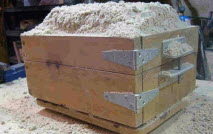Spent Foundry Sands Assessment Is Good News
 |
Finding ways to safely reuse wastes generated by industry is key to reducing the need for virgin materials and for disposing of the wastes in landfills or other disposal facilities. One such waste is spent foundry sands, which the Environmental Protection Agency (EPA), now says can be reused in beneficial ways without posing any environmental or health and safety risks, and moreover, actually providing a number of environmental benefits.
Every year about 10 million tons of spent foundry sands are produced but only about 26 percent are beneficially reused. According to the most recent statistics from the EPA (2008), an estimated 220,000 tons of spent foundry sands were used in manufactured soil, and 144,288 tons were used in road construction.
In the recent risk assessment, the EPA, the U.S. Department of Agriculture (USDA), and the Ohio State University (OSU) looked at uses of silica-based foundry sands from iron, steel, and aluminum foundries in three soil-related applications:
- Manufactured soil (i.e., blends of soil, soil components, and soil-like material used in horticulture/ landscape applications and large volume applications like site restoration);
- Soil-less potting media (i.e., a sterile mix of natural ingredients processed according to certain specifications and used to raise plants in controlled conditions, like greenhouses and cuttings beds); and
- Roadway sub-base which is a foundation layer of roads.
Forget expensive calls to lawyers and consultants. With Enviro.BLR.com, you get instant access, 24/7. Try it out today and get the 2015 EHS Salary Guide, absolutely free. Download Now.
In the risk assessment, the collaborative effort evaluated the sands for each use by:
- Reviewing available information on spent foundry sands in soil-related applications;
- Identifying likely exposure pathways and receptors associated with various uses;
- Combining screening and modeling methods to determine whether the proposed uses of spent foundry sands are protective of human health and the environment; and
- Discussing the findings within the context of certain overarching concepts (e.g., the complexities of soil chemistry) and providing conclusions.
Based on the conclusions of the risk assessment, the EPA is on the record in support of beneficial reuse of the silica-based spent foundry sands specifically used in iron, steel, and aluminum foundries. The EPA notes, however, “spent foundry sands from leaded brass and bronze foundries are often regulated as hazardous waste. Spent foundry sands from nonleaded brass foundries and spent foundry sands containing olivine sand are also not evaluated in this risk assessment.” In addition, the EPA says, “This assessment … applies only to molding and core sands that have been subjected to the metalcasting process and can no longer be used to manufacture molds and cores. To the extent that other foundry wastes are mixed with spent foundry sands, the conclusions drawn by this assessment may not be applicable.”
What does this mean in real-world benefits? Plenty, according to the EPA. On the environmental side, the EPA breaks out the benefits as follows:
|
Environmental Benefits of Spent Foundry Sands Beneficial Use |
||||
|
Avoided Impacts |
Road Base Use |
Manufactured Soil Use |
Total avoided impacts |
Equivalencies |
| Energy Consumption
(megajoules) |
17,800,000 |
27,900,000 |
45,700,000 |
Annual electricity consumption of 800 homes |
| Water consumption
(1,000 gallons) |
3,000 |
4,800 |
7.8 million gallons |
Amount of water to fill 12 Olympic-size swimming pools |
| CO2 Emissions
(metric tons) |
1,500 |
2,500 |
4,000 metric tons |
Removing 840 cars from the road for one year |
Everything You Need for Environmental Compliance
Enviro.BLR.com puts everything you need at your fingertips, including practical RCRA, CAA, CWA, hazardous waste regulatory analysis and activity, news, and compliance tools. Try it at no cost or risk and get a FREE report.
But there are other benefits as well. For example, the EPA says economic benefits of environmental sound reuse of spent foundry sands can also include:
- Reducing the impacts associated with food production,
- Reducing the impacts associated with construction of roads and other infrastructure,
- Job creation in the beneficial use industry,
- Reduced costs associated with spent foundry sand disposal,
- Increased revenue from the sale of spent foundry sand, and
- Savings from using spent foundry sands in place of more costly materials.
